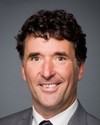Thanks, Mr. Chair.
Actually, if I might request your indulgence, I think we can commit to making all the departmental presentations within a half an hour. I might take a little more time than my colleagues, and they may take a little less than ten minutes. The bulk of the act amends the Canadian Environmental Protection Act, the act that our minister administers along with the Minister of Health. I may have a few more comments to make, but we'll try to keep the comments within the totality of about half an hour.
My colleague from Health Canada, Phil Blagden, doesn't have a presentation to make. He's available to answer any questions anybody may have about the health aspects of the bill.
As members know, Bill C-30 amends three existing statutes: the Canadian Environmental Protection Act, 1999, which I'll refer to as CEPA from now on; the Energy Efficiency Act, which is administered by the Minister of Natural Resources; and the Motor Vehicle Fuel Consumption Standards Act. If anybody can remember the name of that one, they get a surprise at the end of the meeting.
I'll speak to you about the main ways in which Bill C-30 amends CEPA. In order to do that, I am going to spend a few minutes telling you about CEPA itself. For some of you this will be old hat, because you're now experts, having concluded the review of CEPA. For others, this maybe useful before I launch into the specific amendments that the bill makes to CEPA.
A lot of federal statutes address pollutants; however, CEPA is the main framework piece of federal legislation for addressing pollutants. It comprises a number of regulatory regimes. It includes a regime for toxic substances. It includes a regime for regulating fuels and one for addressing nutrients and motor vehicle and engine emissions. It has a complete section that gives the government authority to regulate various environmental issues on federal lands and on aboriginal lands. It has a stand-alone regime for controlling the disposal of waste at sea. It provides a regime for environmental emergencies, and so on.
This is one of the most comprehensive environmental protection statutes in the world. For example, in the United States, the statutes that address the issues that are included in CEPA number at least eight, and probably more than that.
Although the statute covers a number of different regimes, the issue for which CEPA is probably most important, and almost certainly best known, is the toxics regime. That regime is at the heart of the act. Part 1 of the act addresses toxics; parts 3, 4, 5, and 6 address toxics; and part 9 also addresses toxics.
The act provides a comprehensive regime for identifying, assessing, and then managing substances that are found to meet the definition of “toxic”. Essentially, that is a legal definition. It doesn't refer to toxicological properties, it refers to risk to human health and the environment. Risk is a combination of the property of the substance and the potential for exposure, and therefore for harm to human health or the environment.
What the act does is provide a regime for identifying substances. When they're identified and are based on a scientific assessment, where a conclusion is made by the government that the substances need to be managed, those substances are added to what's called the list of toxic substances.
At the moment, under the act, the six greenhouse gases that Bill C-30 proposes to address and the six air pollutants that Bill C-30 proposes to address are on the list of toxic substances. They've been through a risk assessment. In the case of air pollutants, it was a risk assessment done in Canada. In the case of greenhouse gases, it was one that has been the subject of considerable media attention recently, at the international level.
Once the substance is added to the list of toxic substances, the act provides for various authorities to manage the substance in the most efficient manner possible. For example, the government can impose regulations that can restrict or ban completely activities related to the substance. The government can impose a deposit refund scheme. It can establish tradeable permit systems.
The minister has the authority to require a user or a producer or an emitter of a toxic substance to prepare a pollution prevention plan. Under this authority, the minister can't say, “You must reduce by x”, but the minister can say, “You must prepare a plan and then report it back to Parliament, to the government, to tell us how you're going to prevent emissions from these substances.”
In addition—and here I'm looking at slide 7—the act also provides broad authority to establish various guidelines and codes of practice regarding, for example, industrial processes that would be appropriate to minimize the use or production or emission of these substances.
In addition, there is a completely separate regime in CEPA for fuels and engines. The act provides the authority to regulate fuels and the properties of fuels in order to address air pollution. The act also provides the authority to regulate vehicles and engines. Indeed, there are numerous regulations in place, and more planned for publication in the next year or two, addressing air pollutant aspects of fuels, engines, and vehicles.
In addition to these specific regulatory regimes, throughout CEPA you can find various cross-cutting provisions. Some of these are summarized on slide 8. For example, the act provides the ministers of health and environment with broad research authorities. It also gives the Minister of the Environment in particular the authority to require members of the public and, in particular, industry to submit information that is in their custody, to support the minister's efforts to identify and assess the substance, determine whether the substance needs to be risk-managed, and then to determine the most appropriate manner in which to manage the substance.
There is a comprehensive enforcement regime at the back that is applicable to any regulation developed under the act. Of course, there are also provisions for equivalency and administrative agreements. We'll come back to those in a minute, but essentially these are mechanisms that the federal government can use to acknowledge that a provincial, territorial, or aboriginal government has in place a regime that will achieve an equivalent outcome. Therefore, we can avoid having overlapping federal–provincial regulation, and just have one regulation in place.
On slide 9 we detail some of the other cross-cutting elements that are important features of CEPA. They were present in the original CEPA that was published in 1988, but they became significantly strengthened as a result of the review the predecessor to the current environment and sustainable development committee conducted in the mid-1990s. As a result of that review, CEPA was considerably strengthened with respect to the obligations it puts on the ministers of environment and health to allow for public participation in virtually every important phase of decision-making under the act.
In addition, the act establishes a national advisory committee comprised of federal, territorial, and aboriginal representatives, to ensure that before any important decision is taken, those representatives are consulted and given an opportunity to provide input. They don't have decision-making authority, but we are obliged to consult with that committee.
Finally, there are various accountability mechanisms built into the act, including an annual report that we publish on the administration of the act, and of course the five-year review. The environment and sustainable development committee, as I understand it, is in the process of preparing the report that would represent the second such five-year review.
Turning to slide 10, in a couple of minutes I think I've tried to sketch for you how CEPA provides a fairly solid foundation for regulating pollutants, including air pollution and greenhouse gases. CEPA would enable us to regulate air pollutants and greenhouse gases as toxic substances.
What would Bill C-30 do? Bill C-30 would amend CEPA in two significant ways. First of all, it would amend various provisions in CEPA, tailor them a little bit better to ensure that they are more directly applicable to air pollutants and greenhouse gases. In addition, Bill C-30 would establish a clean air part, a new part in the act specifically designed to allow the government to collect information about air pollutants and GHGs and to develop risk management regimes, in particular, regulatory regimes, specifically for greenhouse gases and air pollutants.
The next eight slides summarize the key ways in which Bill C-30 would amend CEPA. First of all, in terms of the scope of Bill C-30—looking at slide 11—the first important change is that the bill explicitly states that air applies to indoor and outdoor air. So wherever you read “air” in CEPA, if Bill C-30 were to pass, you would read “indoor and outdoor air”. For example, any of the research authorities, any of the information-gathering authorities, or any of the regulatory authorities could be applied to indoor air. And of course, most of us spend most of our time indoors rather than outdoors. While outdoor air certainly poses significant health risks to Canadians, so does indoor air, indeed maybe more so, if you care to ask my colleague from Health Canada.
The bill would also slightly amend the current definition of “air pollution”, but it would still be broad enough to include smog, acid rain, and climate change. It would define air pollutants as the items listed on slide 11: particulate matter, ozone, volatile organic compounds, gaseous ammonia—these are all smog precursors—nitrous oxides and sulphur dioxides, which contribute to smog and acid rain, and mercury. As I mentioned earlier, each of these items is currently listed as a toxic substance. Were Bill C-30 to pass, these items, with the exception of mercury, would be removed from the list of toxic substances and would be managed and regulated as air pollutants alone. Mercury would remain on both lists because of course it's a problem in water and soil as well as in the air.
Similarly, the bill would define the six greenhouse gases as greenhouse gases that are currently on the list of toxic substances. In late 1995 the government added those six gases to the list of toxic substances, giving the government the authority to regulate them under the toxic substances provision. What Bill C-30 would do is take them off the list of toxic substances and define them as a greenhouse gas, and then enable the regulation of those substances under the new clean air part as a greenhouse gas.
In addition, the bill would give the Governor in Council the authority to name additional substances either as an air pollutant or a greenhouse gas, provided that the Governor in Council was satisfied that the substance contributed, or was capable of contributing, to air pollution—in other words, smog, acid rain, or climate change.
Slide 12 summarizes the way in which the bill would establish an accountability regime specifically tailored to air pollutants in greenhouse gases. At the moment, CEPA enables the minister to establish environmental quality objectives, publish a state of the environment report, publish a summary of emissions from large sources in Canada, and provide an annual report.
Those obligations would stay. But in addition to those, Bill C-30 would require the ministers to set ambient air quality objectives. In other words, we're not talking about an emission limit. We're talking about how much of this stuff do we want in the air? What's the ideal limit for these two major smog precursors?
It would be a benchmark against which future governments would be assessed by their colleagues and by the government in terms of the success at reducing emissions. It would also require the ministers to monitor the attainment of those objectives on a regular basis, and it would require the ministers to report annually on a bunch of things about which they're not currently required to report.
On attainment of air quality objectives, it would require an annual report on air quality in Canada. It would require a report on the effectiveness of actions that are being taken by all governments in Canada, not only by the federal government but by all governments.
We're not giving the federal minister the authority to intervene in a province and say they must do A or B. But the bill would give the ministers of the environment and health the obligation to report on the effectiveness of actions that are being taken by all levels of government in Canada, in recognition that all levels of government have a direct impact on air quality, and of any plans that the ministers have for additional actions to improve air quality.
Next are the expanded authorities that the bill would give to the ministers to conduct research and to monitor and gather information on air issues. There would be expanded and tailored authorities to do research and information-gathering on air issues.
The Minister of Health in particular would receive expanded authorities to do these kinds of activities. At the moment, the Minister of Health's authority to do research and collect information under CEPA is actually quite limited. Of course, not so much on the greenhouse gas side but on the air pollution side, we're primarily talking about health issues. The authority of the Minister of Health would be considerably expanded on the science side of the issue, both to understand the issue and in order to be able to monitor the ongoing impacts of government interventions. For example, there would be a new authority to conduct biomonitoring.
In addition, there's the proposed expansion in the government's regulatory powers. At the moment, as I indicated earlier, under the toxics provisions and under the fuels, engines, and vehicles provisions, CEPA provides fairly broad authority to regulate air pollutants and greenhouse gases as toxic substances.
Bill C-30 would do a couple of things. First, the authority wouldn't be tied to the linkage to toxic. The authority would be given to these substances as to what they are, air pollutants and greenhouse gases.
Second, the authorities that you find in proposed part 5.1, in the clear air part, have been tailored to air pollutants and greenhouse gases.
For example, there are certain authorities that may be appropriate regarding the kinds of requirements that one might want to include in a regulation about how a “regulatee” should monitor or report on emissions. It's very hard to report in many cases precisely on what is coming out of the stack. In many cases, mathematical modelling is required. We don't want facility A to use a different model from facility B, so we might want to be able to specify the kind of modelling that's done. We don't have the authority now. It would be provided in the new bill.
A significant enhancement would be the ability to regulate products that create air pollutants. At the moment, we can regulate products that contain and emit air pollutants, but we can't regulate a product that doesn't contain an air pollutant. A wood stove is a good example. A wood stove is an inert piece of metal or cast iron. There's nothing wrong with a wood stove when it's sitting there. When you put wood in it and you fire it up, particulate matter and other stuff come out of the chimney. We can't regulate the way a wood stove is designed at the moment, because there's no toxic substance in the wood stove. What we would like to be able to do is regulate the way a wood stove is designed to ensure that it is as efficient as possible, to minimize the particulate matter and other smog-causing emissions it creates.














